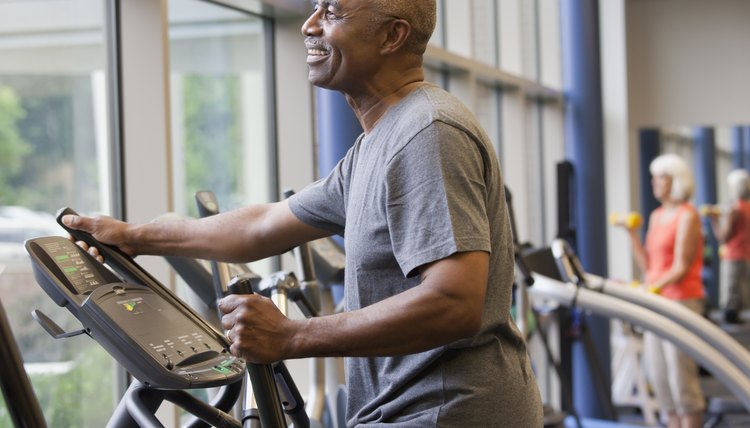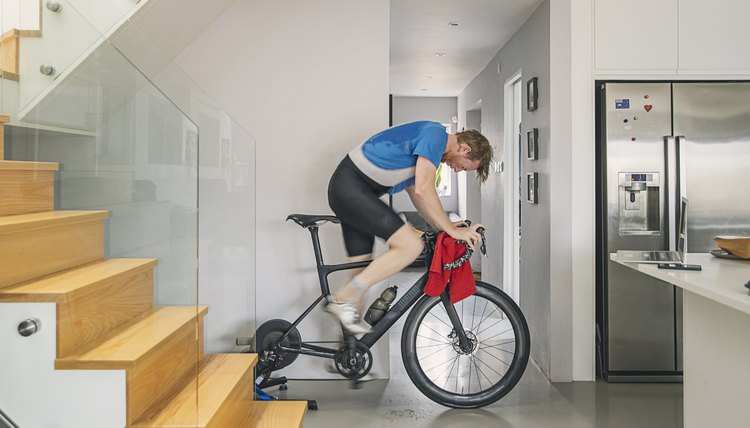The Meaning of RPM in Exercise

On many cardio or aerobic machines, you will see the acronym RPM but many are unaware of what it actually means. The acronym RPM stands for revolutions per minute. Exercise machines that have arms or pedals that must be moved in a circle are devices that track RPM to help measure speed, intensity and how hard you are working on the machine. High RPM workouts can increase heart rate, weight loss, calories burned and eliminate body fat. The three most common devices that utilize RPMs are arm ergometers, elliptical machines and stationary indoor cycling machines.
What is an Arm Ergometry machine?
An arm ergometer is a device that has two hand attachments that attach to a flywheel and arm crank. The goal of the exercise is to rotate the crank against resistance set by the machine. Rotations per minute for an arm ergometer lets you know how many times you have completely spun the flywheel around during that time. The exercise is performed from a seated position and is a low impact upper body workout. It’s not common in many cardiovascular or cardio peak training regimens because of its little lower body impact. Arm ergometry is suitable for individuals with lower-body impairments and may be used for strength training after a broken arm has healed to help return strength to the affected arm and mobility to the shoulder joint.
What is an Elliptical Machine?

hamburguesaconqueso/iStock/Getty Images
An elliptical is a low-impact piece of exercise equipment that typically requires both your arms and legs to move in tandem to produce movement. It promotes a high fitness level and is a major part in achieving many fitness goals. The foot pedestals are connected to a circular flywheel that provides resistance during the circular movement of the pedestals. Ellipticals can be pedaled forward or in reverse. The calculation of RPMs for an elliptical stems from how many times the elliptical flywheel has made full clockwise or counterclockwise rotations per minute.
It is a great Cardio peak training exercise, which involves keeping your heart rate in a steady state in the “sweet spot” which is 60-80% of your maximum heart rate. It is also a good exercise for high-intensity interval training as well. For those looking for a form of exercise that lowers blood pressure, an elliptical is perfect.
What is a Stationary Cycling Machine?

hamburguesaconqueso/iStock/Getty Images
The stationary bike also uses RPM to help gauge exercise tempo. Stationary bikes require the user to push pedals with their legs to spin a wheel. Two different versions of stationary cycles are available -- a seated bike and a recumbent bike. The seated bike requires you to push the pedals, located below you, from a seated position. The recumbent bike requires you to push pedals located on the same horizontal line as the rest of your body. The motion is very similar to riding a regular bike on a flat road but without the movement.
Rotations per minute on a stationary bike are calculated by determining how many full turns are made from the flywheel that is attached between the pedals per minute of exercise. Some high tech bikes can mimic a hill climb by changing elevation and making a pedal stroke much harder. Spin classes, or cycling classes, have become very popular with their various health benefits and fun upbeat theming.
Considerations
Although RPM is one way to determine pace during exercise, it is only one part of the picture. You must also consider the resistance level at which you've set the piece of equipment you are using to determine how fast you are going. Typically, resistance multiplied by the RPM by the length of the flywheel dictates how fast you are going. Exercising at the same RPMs with different resistance setting means you are not performing the same amount of exercise.
References
Resources
- "ACSM's Resources for the Personal Trainer"; American College of Sports Medicine; 2007
Writer Bio
Joshua Bailey has been writing articles since 2006 with work appearing at Bodybuilding.com and 2athletes.com. Bailey holds the following certifications: NASM-CPT, NASM-PES, NASM-CES and NSCA-CSCS. He also holds a Bachelor of Science in exercise and sports science from the University of North Carolina, Chapel Hill and a Master of Science in exercise physiology from the University of North Carolina, Greensboro.
